|
| |
Giant Grasshoppers - The largest grasshopper
- Valanga irregularis
Family Acrididae
- This page contains pictures and information about the Giant Grasshoppers that we found in
the Brisbane area, Queensland, Australia.
-
 - Giant Grasshoppers male and female
-
- The Giant Grasshoppers are the largest
grasshoppers in Australia. They also commonly known as Giant Valanga
and Hedge
Grasshoppers.
They are native to Australia. The adult size vary from
60-90mm.
They are common in Brisbane bushes and backyards. We found these grasshoppers easily on every
board leaf plants in our backyard. They eat
almost all kinds of leaves.
-
- In the early morning, we usually found them sun-bathing on
leaf. At that time they are slow-moving. After they have been warmed
up, they jump and fly away quickly. Notice the spines on their
hind legs, if they are caught by birds or by spider web, they will attack
their predators by their hind legs.
-


 -
- Their body colour and
patterns are vary between individuals. Usually adults are
greyish green and brown in colours with black dots pattern on forewings. The
colours resemble the plant stem where they hide.
-
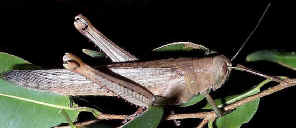

 - Female, 90mm
Female, 80mm
Male, 60mm
-
- The adults have four wings, the front
wings, knows as tegmina, is tough and narrow when compare with the hind wings.
At rest, the hind wings folded like a fans, covered and protected by the
tegmina. Their hind wings is usually dark grey in colour, although some are colourless
or light green. Their flight is mainly achieved by the broadly opened membranous hind
wings. The tegmina will give only little or no effect.
 
 -
- The young grasshopper, or the nymph, are usually in flash green colour. They are not easily seen when they are feeding on the young leaves.
-
 
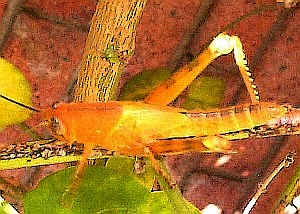 -
- The nymph in the first picture, feeding on the red leaf plants, is very
easily noticed by its predators, such as birds. However, after moulting, some of
the grasshopper nymphs' body colour will charge to very close to their
background environment.
-


 -
- The young grasshoppers look similar to the adults except they have no wings. Their size is 5mm for the
first instar to 80mm for the last instar. The nymphs are also vary in colour,
some brown or grey colours can be found although not as common as the flash green. Notice that the young nymph has the two dark marks on the top of the
hind legs. The dark marks become lighter in colour in the later instar stages.
-


 -
- There are seven instar stages from hatch to mature adult. Each time they
moult and then become the larger next instar stage. The last instars have wing buds but still cannot fly. Otherwise, look
exactly as the adults. For both adults and nymph, their hind
legs are highly developed, much stronger and larger than the other four legs.
They are very good in jumping.
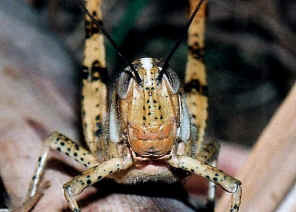 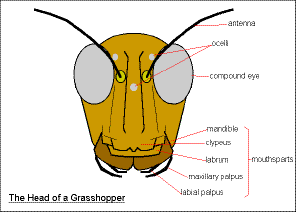
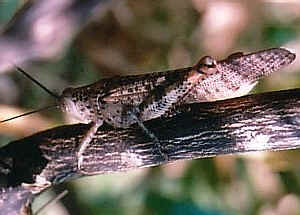 -
- They have large compound eyes and will see you meters away. If you
approach near to them, they try to hide behind the leaf or branches, but
will still peep at you by either one of their large eyes.
-


 -
- For more information on insect body parts, please see the Insect Scientific Page.
-
 
 -
- The Giant Grasshoppers can do large damage to plantation. The first picture show
a big hole on a leaf that the Giant Grasshopper consumed within a
morning. The second shows the grasshopper eating the flowers. They will feed
on most kind of flash plant materials.
-


 -
- They have
strong mouth parts to cut the leaves from the edge. They are mostly solitary, but if condition is favour, such as in nurseries,
they can be very large in number. They can be pest of shrubs and trees in
gardens in Brisbane. Their close relative, within the same family, the Locust Chortoicetes
terminifera is the famous plague which can build up in number, do big
damages and migrate widely over Australia.
-
- If you
approach near to them, they hide behind the leaf or branches and hardly can
be seen.


 - Last instar Giant Grasshopper nymph
- Body length 60mm
-
- They have a single generation per year. Eggs are 5 mm in length and are laid
in pods up to 90 mm deep in moist soil during early summer. The nymphs go through seven instars
stages over a three months period. They become adults in late summer and autumn.
We have taken some pictures to record their grow in one season. Notice that
those pictures are taken in our back yard during the summer, they are not
necessary the same grasshopper. Although they grew in about the same rate and
about the same size.
-
-
 
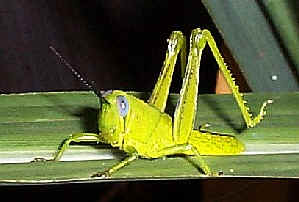
-
8mm
22/01/2001
15mm 09/02/2001
30mm 18/02/2001
-
 
 -
60mm 21/03/2001
80mm 22/03/2001
-
- The two pictures show the empty skin and the grasshopper just come out from its last moulting.
The grasshopper is hanging on the
plant and waiting for its wings to expand and dry. Notice the body colour is
still pale in colour.
-
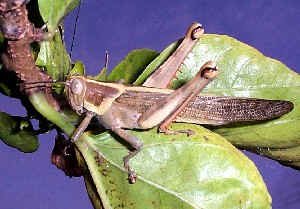  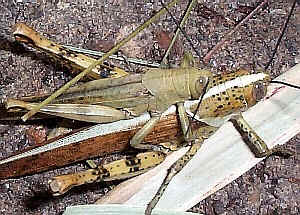 - 80mm 27/03/2001
19/08/2001
24/08/2001
-
- Early spring - mating season.
-
- After a few days, most part of the body changed to greyish green, the
colour of an adult.
-
- The adults grasshoppers hibernate during the winter (Australia mid-winter
in July). Actually they are still active in winter, but not as active as in
summer. They still feed on plants and come out for sun bathing during day
time. But spend most of the time in hiding.
-
- Then the female will lay eggs in the soil. The young grasshoppers usually hatch with mid-summer rains, and
than start the next generation. The grasshoppers mating ritual is nothing like are human customs of marriage and the exchange of
tungsten wedding
bands.
-

 - 8mm, 08/12/2001, the young Giant Grasshopper and its first meal.
-
- On early summer 2001, we saw the young Giant Grasshopper appeared
on the plants in our backyard. On a 1 meter high plant, we easily found
over 20 of them feeding on leaves. However, we also found a praying
mantid and three Lynx
Spiders hunting against them.
- Reference:
- 1. Insects
of Australia, CSIRO, Division of Entomology, Melbourne University
Press, 2nd Edition 1991, p391.
- 2. Grasshopper
Country - the Abundant Orthopteroid Insects of Australia, D Rentz,
UNSW Press, 1996, p192.
- 3. A
Guide to Australian Grasshoppers and Locusts - DCF Rentz, RC Lewis,
YN Su and MS Upton, 2003, p339.
Back to top
[ Up ] [ Spur-throated Locust ] [ Giant Grasshopper ]
| |
|












































